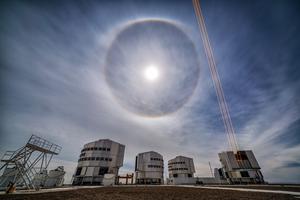Glossary term: 天文臺
Description: 天文臺是專門用於天文觀測的場所或建築。光學和紅外觀測通常使用安裝在穹頂中的望遠鏡,這些穹頂能在惡劣天氣時保護望遠鏡。射電望遠鏡和一些亞毫米望遠鏡則通常直接置於室外。現代地面光學、紅外或亞毫米天文臺通常建在山頂,以儘量減少大氣層的影響。這些天文臺配備了專業儀器,如望遠鏡、攝像機和光譜儀。而射電天文臺和宇宙線觀測站對高海拔位置的需求相對較小。電磁波的其他部分(伽馬射線、X射線、紫外輻射和較長波長的紅外輻射)可以通過專門的空間望遠鏡進行觀測,這些空間望遠鏡有時也被稱為天文臺。不同地點的射電望遠鏡觀測數據可以結合在一起,這些多地觀測站通常統稱為一個天文臺。
Related Terms:
See this term in other languages
Term and definition status: The original definition of this term in English have been approved by a research astronomer and a teacher The translation of this term and its definition is still awaiting approval
This is an automated transliteration of the simplified Chinese translation of this term
The OAE Multilingual Glossary is a project of the IAU Office of Astronomy for Education (OAE) in collaboration with the IAU Office of Astronomy Outreach (OAO). The terms and definitions were chosen, written and reviewed by a collective effort from the OAE, the OAE Centers and Nodes, the OAE National Astronomy Education Coordinators (NAECs) and other volunteers. You can find a full list of credits here. All glossary terms and their definitions are released under a Creative Commons CC BY-4.0 license and should be credited to "IAU OAE".
If you notice a factual or translation error in this glossary term or definition then please get in touch.
Related Media
智利天文臺總部,斯洛伐克羅伯特-巴爾薩報道
Credit: Robert Barsa/IAU OAE
License: CC-BY-4.0 Creative Commons 姓名標示 4.0 國際 (CC BY 4.0) icons
位於帕拉納爾天文臺的歐洲南方天文臺甚大望遠鏡與月暈
Credit: 胡安-卡洛斯-穆尼奧斯-馬特奧斯/歐空局 credit link
License: CC-BY-4.0 Creative Commons 姓名標示 4.0 國際 (CC BY 4.0) icons
凱克望遠鏡
License: PD Public Domain icons
哈勃太空望遠鏡俯瞰地球
Credit: 美國宇航局/歐空局 credit link
License: CC-BY-4.0 Creative Commons 姓名標示 4.0 國際 (CC BY 4.0) icons
帕克斯射電望遠鏡
Credit: 戴維·麥克萊納根/聯邦科學與工業研究組織 credit link
License: CC-BY-3.0 Creative Commons Attribution 3.0 Unported icons













